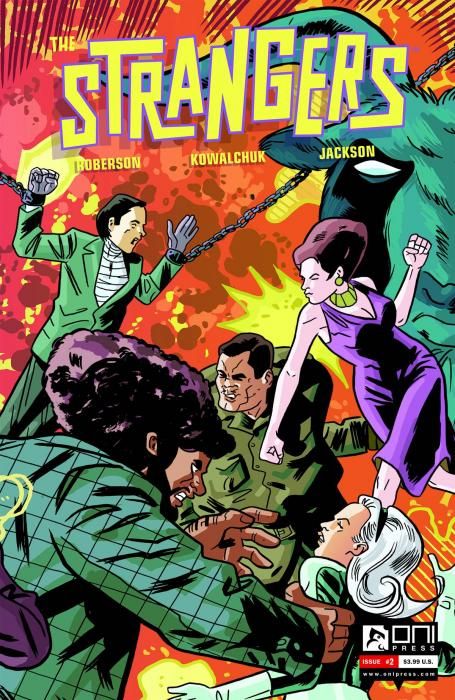"The Mysterious Strangers" #2 by Chris Roberson and Scott Kowalchuk is a snappy conclusion to the introductory story arc, revealing how the team solves the mystery of the ancient temple and stops the evil plans of Marie Furie and the evil O.C.C.U.L.T. organization.
The origin of the three main characters and their leader, Absalom Quince is yet to come, but more about their powers is revealed. Like Charlie's Angels and other teams of international agens, the characters are static types. Dashing Verity is the capable leader, Michael Kono is a ladykiller and Sandoval is the grumpy strong man. The intra-team interaction is friendly and upbeat, but nothing out of the ordinary.
The dialogue, story structure and Kowalchuk's art all have a retro 1960s vibe, complete with "jungle natives" and dastardly villains who announce their megalomaniacal plans while the heroes are trussed up. Of course, this leaves an opening for one of the heroes to conveniently escape their bonds and save the day. Some plot threads dangle at the end of the arc, including why the spaceship was transmuting humans into aliens.
Kowalchuk's art is reminiscent of Mike Allred's in its clean pop-art lines and energy, matching tone of Roberson's script. Details like Marie Furie's beehive hairdo and Tabu's plaid suit bolster the rich vintage aesthetics, and there are cute visual jokes, like the frowning face on the temple's outer wall. Jackson's vivid colors are attractive, especially for the nighttime sky and jungle foliage. The action and transitions in setting are easy to follow, and in particular, Verity's powers and her communication with the aliens was a fun near-psychedelic touch, both in Roberson's wordplay and in Kowalchuk's depiction of Verity's disembodied floating spirit.
"The Mysterious Strangers" #2 is an enjoyable light-hearted read, but it also suffers from the flaws of its role models, although the flaws are so well-known and parodied that they have acquired a patina from nostalgia. Marie Furie's villainous monologue is a three-page information dump. All three team members get to show off their distinctive abilities to defeat the villains, although it's a subversive touch by Roberson to have Verity do most of the legwork and brainwork while Sandoval spends most of "The Mysterious Strangers" #2 being mind-controlled or looking surly. The wrap-up is far too neat to be believable. Finally, the plot mechanics are episodic and workman-like.
However, it's debatable whether these flaws are truly flaws, since they are a deliberate reproduction or mimicry. Roberson seems to be aiming for a camp aesthetic, poking a little fun, but mostly just enjoying both the ridiculousness and the high spirits of an era of adventure, science fiction and espionage stories, including the "James Bond" and "Indiana Jones". The reader's mileage with "The Mysterious Strangers" #2 will vary widely, depending on how much charm this kind of pop nostalgia appeals to individual tastes.

